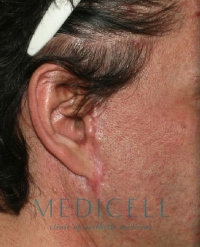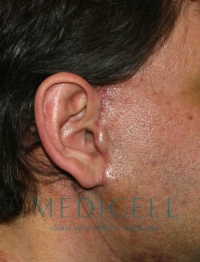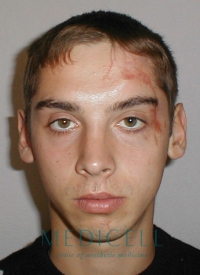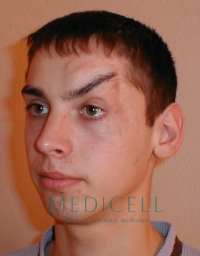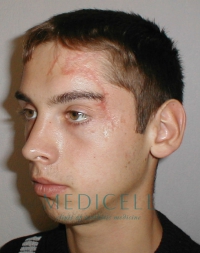Correction of scars
We all know that the slightest damage to the integrity of the skin leads to the formation of unsightly skin defects – the scars. In most cases, we get them in childhood. We are sure each of you has experienced something like this - you have fallen from the tree or bicycle, dissected various parts of the body, you had the appendicitis removed, you experienced bites of a dog or you fought with bullies resulted in various “battle” injuries. In the process of healing of these all the scars are formed.
Pain in the knee is forgotten, resentment resolves, but the scars remain with us for life. Over time, they are deformed, distorted and cause a huge aesthetic and psychological discomfort. Unfortunately, this fact and have remained the same, if not a brilliant discovery of medicine - modern plastic surgery, which is able to minimize their severity.
Types of scars and their features
There are 4 types of scars:
- Normotrophic;
- Atrophic or hypotrophic;
- Hypertrophic;
- Keloid.
Normotrophic scars are formed usually after acute careful dissection of tissue (injury with a sharp object or as a result of surgical intervention). They are not much different from the main skin. Elastic, not alter or distort the skin around them.
Atrophic scars have more retracted surface. The thickness of the scar at length and width is greater than that of normotrophic, and physically located below the main skin. The scars of this type are the result of infectious diseases (eg, chickenpox), trauma, surgery, stretch marks skin tissue (in the chest, abdomen, thighs as a result of improper skin care during pregnancy, rapid weight loss or growth, etc.)
Hypertrophic scars rise above the skin and are the result of a more rapid proliferation of connective tissue in the healing process of injured tissues, or as a result of improper care of the wound.
Keloids are usually most pronounced: a characteristic bluish or pink color, bumpy and shiny surface, cartilage-like structure, cause itching and pain. From the width of two or three times the damage zone itself. On the surface of the body there are areas that are prone to the formation of keloids. Often they are formed in the chest, deltoids, and earlobes.
In the correction of scars the specialists have resorted to two main methods - conservative and surgical.
Conservative method of scar correction
The conservative correction includes the following procedures:
- applying to the scar special ointments and gels;
- use of special silicone wafers;
- pressure therapy - the use of compression bandages and linen;
- x-ray therapy – bucky-therapy and close focus X-ray therapy;
- injection into the thickness of the scar and hormonal absorbable preparations;
- physiotherapy procedures using electric and phonophoresis absorbable agents;
- massage and others.
For non-surgical procedures can be attributed to different methods of scar resurfacing - laser resurfacing, cryosurgery, dermabrasion, chemical peels, and others.
Indications for conservative correction
This treatment is applicable in cases of keloid and hypertrophic scars and takes a long period of time. Its purpose is to eliminate chronic inflammation and infiltration of scar tissue and scar reduction to normotrophic state.
What is the laser surgery and its advantages?
Laser correction is based on reducing the amount of scar tissue by evaporation or burning it, but does not affect the area on the skin surface.
Surgical scar correction method
The most effective and safest method of scar correction is surgery. The procedure is applicable in the case of correction of hypo- and hypertrophic scars. The specialist conducts the removal of the scar, and then stitches the skin layer by layer edge, distributing tension to the deeper layers. Thus, the epidermis is exposed to the minimum load that allows you to apply a cosmetic seam with little or no tension.
Features of the postoperative period
A few days after the operation, the patient should wear a bandage. After removal of sutures for several weeks it is recommended to use various gels based on silicon. The time of formation of the scar is 3-8 months (depending on the characteristics of the skin, scar placement, etc.). As a result of this operation significantly improves the condition of the scar and its visualization.
Correction of contractures
Scars formed as a result of burns or other injuries that suffered the loss of a certain area of the skin can pull off the edge of the area around the damaged area. This entails a disruption of the surrounding muscles and joints that may affect the completeness and naturalness of movement, gait, etc. In this case, we apply the method of excision of the scar and transplant the required flap of skin tissue at the damaged area.
Such operations are carried out under general anesthesia with the mandatory hospitalization of the patient. Healing and recovery can take several months. Over the next year the patient is recommended to wear a bandage fixing.
Z-plasty
This surgical technique is aimed at modification of rumen according natural skin lines and folds, which makes it less noticeable. Old scar is removed and in its place a new incisions are made, separating the skin into triangular patches. Then, these patches are reversed, and the shape of the scar reminds in outlines the letter Z. The wound is superimposed with the cosmetic sutures, which can be removed after a few days. The operation is performed under local or general anesthesia and requires hospitalization. The result of the procedure: the scar remains, but its expression is significantly reduced.
What individual characteristics should be taken into account while the correction of scars?
The results of various scars correction techniques can be affected by the following factors:
- The place of the scar
The thinner and more elastic is the skin, the less noticeable will be the scar. For example, scars in the skin age almost invisible, while the same scar on the back will have pronounced contours.
- The cutting line
The more accurate the scar line follows the natural lines and folds of skin, the more natural it looks, and sometimes not at all noticeable.
- Age
Young people tissue scarring is much more active. In older people, the activity of the scar tissue is reduced and scars are completely invisible.
- Colour of the skin
The skin of black people, mulattoes is more prone to the formation of keloids. The owners of a lighter, pale skin has a predisposition to the formation of hypertrophic scars reddish hue.
Contradictions for scar correction
If you suffer from inflammatory diseases of the skin, rosacea, herpes, atopic dermatitis, acute systemic diseases, the number of plastic treatments is contraindicated.

